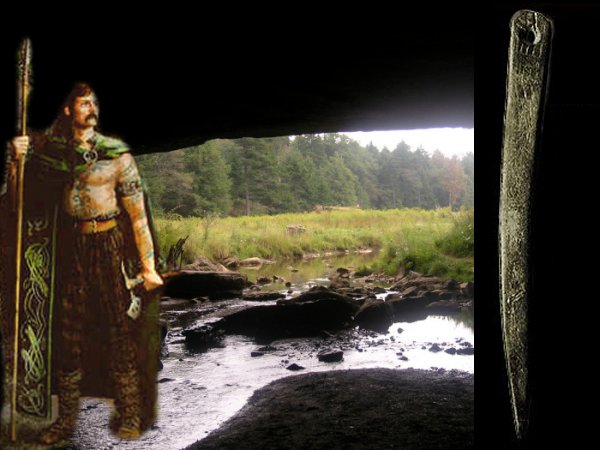Ancient Mysteries Of West Virginia: Did Ancient Celts Visit North America Where They Left An Ogham Inscribed Bone Needle With Christian Symbols?
– As we continue to explore ancient mysteries of North America, we come across a very puzzling discovery made in a cave in West Virginia.
It’s a controversial and very intriguing find, that could re-write history of North America. Who were the mysterious petroglyph people who left behind a puzzling artifact inscribed in Ogham and covered with Christian symbols? Did the ancient unearthed skeleton belong to an unknown European explorer who reached America 800 years before Columbus?

Is there an ancient connection between Ireland and West Virginia we still know nothing about?
Our quest for truth takes us back to the year 1989 when archaeologist Robert Pyle discovered remains of a human skeleton in a rock shelter at the Cook petroglyph site in Wyoming County, West Virginia. Pyle who had been exploring the mountains of southern part of the state studying petroglyphs became intrigued with the discovery of this ancient unknown man and wanted to learn more about him.
Pyle had previously found Ogham petroglyphs on an ancient bone needle not far from the site started to wonder if there was any connection between the two discoveries.
Examination of the bone needle revealed the artifact was etched with Ogham, an ancient Irish alphabet. The bone was very old. Scientists dated it to 2,300 B.C, but the markings on the needle were created sometime around the 5th or 6th century A.D.
Pyle suspected the bone needle had been left by ancient Celts from Ireland. But as we all know, to suspect one thing is easy, but to prove it is much more difficult. Pyle decided to travel to Ireland.
Perhaps the answers to his questions could be found on the Emerald Island (a poetic name for Ireland due to its green countryside). In Ireland Pyle studied several Ogham artifacts with the guidance of Irish experts. Them, he returned to West Virginia and continued his excavations.
The bone needle created a controversy among scientists and man had doubts the artifact was genuine.
The artifact was examined by several experts who made plenty of analyses.
After an extensive amount of study, a conclusion was reached – the bone needle was etched in Ogham, an Old World script. Experts in Ogham from the Ireland and University of Maryland stated the artifact was genuine.
According to Dr. William Grant, Edinburgh University, Scotland, and Dr. John Grant, Oakland, Maryland, both Celtic linguists/scholars, who participated in Pyle’s Ogham research in southern West Virginia, there was no doubt that the artifact was authentic archaic Ogham.
Nevertheless, many other scholars were not impressed and most simply laughed it off or ignored the controversial artifact, pretending it never existed.
The negative attitude did not discourage archaeologist Pyle. Instead he became more and more determined to unravel the mystery of the ancient skeleton unearthed in the cave and establish the man’s origin. Pyle continued to study the site and look for clues. Somewhere there must be something that could help him find out what really happened in West Virginia all those years ago.
Pyle was convinced the unearthed ancient skull discovered in 1989 was of an adult male. According to Pyle, it “was sufficiently preserved to recognize a unique brachycephalic (round headed) feature indicating a possible European origin.” Based on the archaeologist’s experience, the condition of the remains indicated great age.
Of course, Pyle knew, he couldn’t prove anything without laboratory tests.
In 2000, Pyle funding became finally available from a private source and Pyle could find out if his theory was valid. The ancient skull from the cave in West Virginia was examined by experts. Mitochondrial DNA was extracted from the roots of the teeth and compared to previously cataloged DNA sequences from ethnic groups around the world.
Radiocarbon dating conducted on a sample from the established the age of the remains at 1,292 +/-40 years old (about the year 710 +/- 40 years AD).
“These combined scientific data from DNA and C14 testing establish the presence of a person of European origin in southern West Virginia around the year 710 AD, the earliest date that a European has been positively identified on the North American continent through scientific data.
There have been numerous theories and extensive controversy for the past two centuries about pre-Columbian visitors to this continent, but no suitable remains have been discovered and available for testing with any conclusive results until now, “ Pyle said.
The closest DNA were as Pyle suspected of European origin, but was the man who died in the cave an ancient Celt? This question remains unanswered.
The closest DNA were as Pyle suspected of European origin, but was the man who died in the cave an ancient Celt?
We already know that Columbus was not the first to discover America.
In 2016, archaeologists discovered a second Viking site ever found in North America. It’s a truly significant historical find that offers tantalizing evidence of a Viking presence 300 miles from the only place in Canada they’d ever been seen before.
According to scientists examining the area, Point Rosee, the ancient site can be traced to the Vikings. If it was not established by the Vikings, then we are seeing ancient remains of an entirely new culture.There is also a controversial theory suggesting that ancient Chinese visited North America 2,500 years ago.
Evidence of ancient Celtic activity has not yet been confirmed by scientists, but there are many puzzling archaeological discoveries that indicate Celts did reach North America and even Canada.
There are those who believe the Peterborough petroglyphs could offer evidence ancient Celts visited Canada 2,000 years ago.
New Hampshire Mystery Hill, also known as America’s Stonehenge has puzzled scientists for centuries. The stones and inscriptions discovered at this location offer evidence clearly showing that Columbus was not first person to reach the New World.
Was America’s Stonehenge perhaps built by ancient Celts?
Evidence suggests that North America was colonized long before the birth of Christ. Did an advanced civilization arrive on American shores thousands of years ago? Who were they? Where did they come from?
Written by Ellen Lloyd – AncientPages.com
Copyright © AncientPages.com & Ellen Lloyd All rights reserved. This material may not be published, broadcast, rewritten or redistributed in whole or part without the express written permission of AncientPages.com and Ellen Lloyd
About the author:Ellen Lloyd – is the owner of AncientPages.com and an author who has spent decades researching ancient mysteries, myths, legends and sacred texts, but she is also very interested in astronomy, astrobiology and science in general



 Creators of mankind
Creators of mankind Description of “Tall white aliens”
Description of “Tall white aliens” Where they came from?
Where they came from? About hostile civilizations
About hostile civilizations The war for the Earth
The war for the Earth “Tall white aliens” about eternal life
“Tall white aliens” about eternal life Video: “Nordic aliens”
Video: “Nordic aliens” Aliens
Aliens Alien encounters
Alien encounters The aliens base
The aliens base UFO
UFO Technology UFO
Technology UFO Underground civilization
Underground civilization Ancient alien artifacts
Ancient alien artifacts Military and UFO
Military and UFO Mysteries and hypotheses
Mysteries and hypotheses Scientific facts
Scientific facts


















